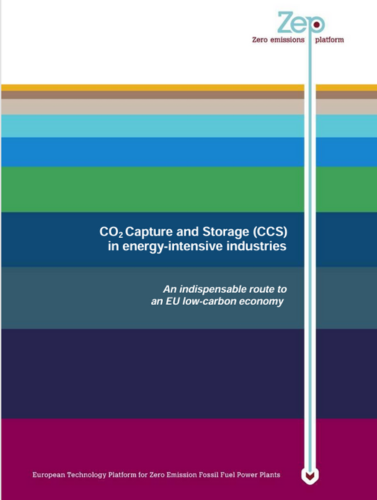CCS in energy intensive industries: an indispensable route to an EU low-carbon economy
Capture
Storage
Jun 26 2013
About the report
Integrating CCS in EU energy-intensive industries is considered an indispensable route for a low carbon economy by 2050. Direct emissions from industry account for 25% of the total EU CO2 emissions. Petroleum refining, iron and steel, cement, and chemical industries account for 60% of the total EU CO2 emissions from industry.
CCS is the only available technology that can deliver the deep emissions cuts required by several AE energy-intensive industries if they are to fulfil their role in a large-scale decarbonisation across the EU economy. CCS has the potential to mitigate between 2 to 2.5 GtCO2 per year globally by 2050. This equates to between 0.3 to 0.4 GtCO2 in the EU27.
Key conclusions
- If the EU is to achieve its ambition of reducing greenhouse gas (GHG) emissions in line with IPCC1 recommendations, emissions must be reduced by 80% to 95% by 2050 to avoid dangerous climate change. This requires large-scale mitigation actions in all sectors of the economy.
- In 2010, direct emissions from industry accounted for 25% of total EU CO2 emissions. Petroleum refining, iron and steel, cement, and chemical industries account for 60% of total EU CO2 emissions from industry.
- Many industrial processes in the EU are operating at or close to the theoretical limits of efficiency, while the release of CO2 is unavoidable in several manufacturing processes. The adoption of current best available and best practice technologies (BAT, BPT) is therefore not sufficient to achieve EU climate targets.
- CO2 capture and storage (CCS) is the only technology that can deliver the deep emission cuts required by several EU energy-intensive industries. According to the International Energy Agency (IEA), CCS is the most important technology option for reducing direct emissions from industry, with the potential to mitigate 2 to 2.5 Gt3CO2 per year globally by 2050 – including 0.3 to 0.4 GtCO2 in the EU27.
- Ensuring a European stake in the global CCS industry will also increase employment in green industries – creating and preserving thousands of jobs; while deploying CCS in industries beyond power will help ensure a competitive position for existing EU industries in a future carbon-restrained world – reconciling EU climate goals with the desired re-industrialisation of the economy.
- Capacity, plant configuration, process arrangement, and age can impact the selection of CO2 capture technologies that could be deployed in an energy-intensive industry.
- Several pilot projects have already validated the technical feasibility of applying CO2 capture to key processes within many of the relevant energy-intensive industries, including retrofit. It could be concluded that retrofitting CO2 capture into the operation of the conventional processes is possible.
- Large-scale demonstration is now essential to validate technical and economic factors in a commercial environment.
- In some industrial processes, mainly in the petroleum refining and chemical sectors, the removal of CO2 is an integral part of the production stream. Such cases could therefore represent relatively lower-cost CCS projects compared to processes with dilute CO2 off-gases – and interesting candidates for early demonstration of the CCS value chain.
- The deployment of CCS for energy-intensive industries in parallel with fossil-fuel power generation could facilitate clusters of CCS projects – improving economies of scale for both CO2 transport and storage, and significantly reducing capital costs compared to stand-alone projects.
Key policy recommendations
- For CCS technologies to become widely deployed in energy-intensive industries from 2030, large-scale demonstration projects are urgently required. New technologies in industry must undergo rigorous testing procedures and standardisation to ensure safety and reliability.
- CCS in the industry can achieve significant CO2 reductions beyond existing EU benchmarks. However, deployment requires a technological and investment step change via supportive policy mechanisms – in terms of both direct project funding and creating a long-term business case.
- Stimulating a European CCS supply chain that takes into account emissions from both power and industrial sectors must be a key deliverable of a European CCS policy. This is critical to maximise the contribution CCS can make to the ‘green growth’ agenda, reducing costs through the stimulation of supply chain competition and securing a European stake in the international CCS industry.
- In many cases, the application of CCS in complex industrial installations will be site-specific. It is therefore essential that a wide range of bottom-up, techno-economic case studies on different processes and capacities are undertaken to understand the cost-competitiveness of CCS deployment.
- A 2015 global climate agreement may not ensure a level playing field for EU industry. The adoption of the UNFCCC ‘common but differentiated responsibilities’ precipitates transitory unequal abatement burdens, meaning that zero carbon leakage is beyond reach. The EU must strive for hard targets in all industrialised nations which represent ‘acceptable leakage’ and focus on reducing the costs of abatement to maintain competitiveness.
- In the case of an absent or excessively unbalanced global climate agreement, border carbon adjustments and sectoral approaches could be carefully assessed as an option for those governments wishing to take strong unilateral action – and develop and commercialise the global technologies needed to counter dangerous climate change.
Download the publication
Share :
